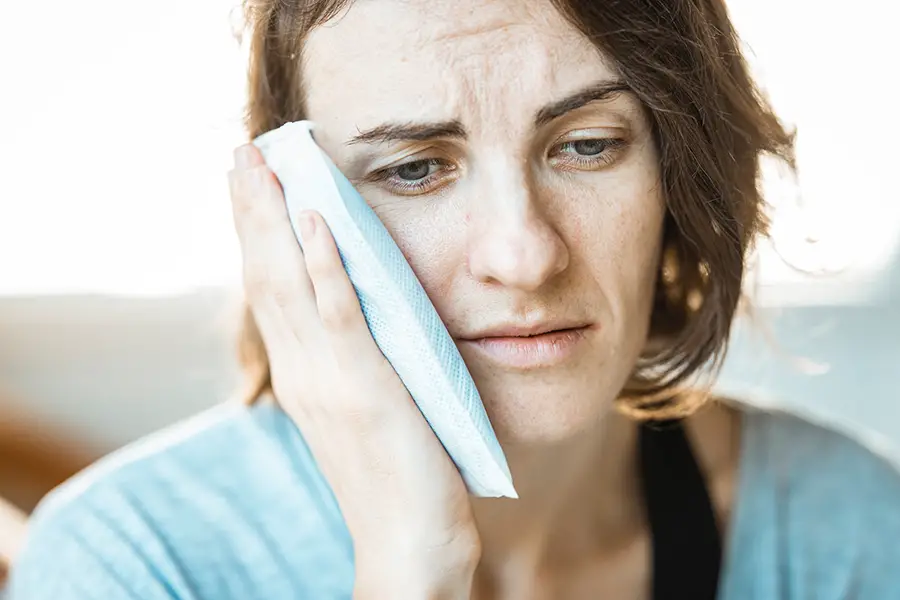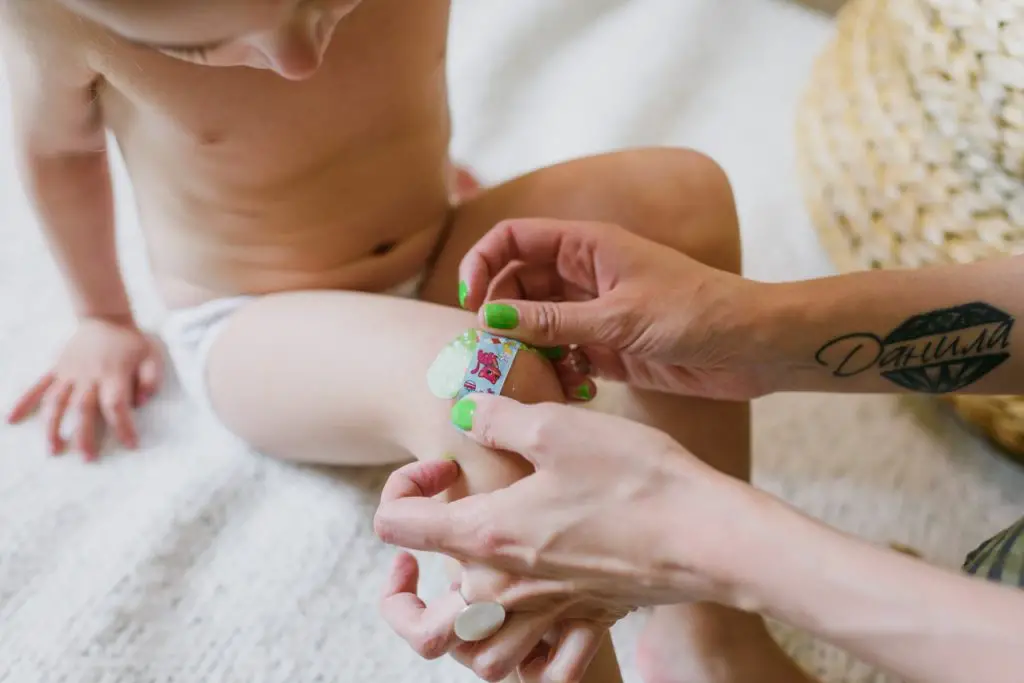You may be asking yourself “why would I need a dental first aid kit”? Maybe a filling popped out when you bit down on something hard? Or maybe you have a toothache? Perhaps you were playing catch and took a ball to the face? When Covid lockdowns happened, dental care wasn’t available to everyone. In the case of a knocked-out tooth, time is not on your side if you want to save it! Having the correct items (and knowledge) on hand will help you to take care of the minor stuff and help your dentist respond to the serious. Whether you’re a coach, a mom, or traveling to somewhere you may not have access to a dentist, you should consider keeping a dental first aid kit on hand.
Components of a dental first aid kit and their uses.
- Surgical gloves
- Gauze
- Dental mirror
- Dental floss
- Salt (and sterile water)
- Pain relief: Benzocaine (oral anesthetic) & Ibuprofen
- Temporary filling / crown kit
- Dental wax
- Save-a-Tooth solution
Surgical Gloves
You’ll want a few pairs of gloves on hand when examining someone else, placing gauze, or applying dental wax in another person’s mouth. Nitrile gloves are best because they do not contain latex.
Gauze
Gauze is used to control the bleeding by applying light pressure over the wound. They can also be used to remove debris or clean the surfaces around the oral cavity. Your best bet is to have a bunch of 2″x2″ individually wrapped pads on hand so you know they are sterile and because of their small size.
Dental Mirror
A dental mirror is a basic component of the first aid kit and can help to see hard to observe areas of the mouth and around the teeth. It can also help to depress the tongue.
Dental Floss
Floss can be used to remove objects or debris between teeth in addition to plaque and food. This tends to be safer than using toothpicks, especially when removing an object from between the teeth.
Salt
A saltwater mix is routinely used for cleaning the mouth. A lukewarm saltwater mixture can be gargled to remove bacteria deposits and clean the oral cavity of debris. It also helps to soothe pain and slow bleeding and promote healing. You can mix 1 teaspoon of salt with 8 ounces of warm water to get the right ratio. The American Cancer Society also suggests adding 1 teaspoon of baking soda, though this is not required.
Pain Relief
For things like a broken tooth or a missing filling, a general OTC product (like Ibuprofen or Aspirin) will work. If its gum related and for some toothaches, you should add a topical ointment that contains benzocaine.
Temporary crown / filling kit
These kits are meant to temporarily fill a lost filling, crown, or cap. They usually consist of a doughy or putty-like material and an applicator tool.
Dental wax
Dental wax can be used to fill the sharp edges of a chipped tooth to prevent it from causing further damage to the tongue and cheek. It can also be used to temporarily fill a dislodged filling.
Save-A-Tooth Solution
This may be available in different brand names, but its unique composition helps to store and protect teeth and keeps the tooth from dying so that a dentist can potentially replace it. Unfortunately, it only keeps the tooth alive for about an hour.
How to build your own homemade dental first aid kit.
It’s not that uncommon for a tooth to get chipped, loosened, or completely knocked out. Just like you would stock your first aid kit with Band-Aids and gauze, you should include items to take care of tooth-related injuries. There is some overlap in materials you will have in a typical first aid kit, but oftentimes it’s easiest to keep a dental kit separated for ease of use in an emergency.
If you’d like to DIY your own first aid kit, I’ve created a complete shopping list for you here.
Are there pre-made dental first aid kits on the market?
There are a few pre-made dental first aid kits on the market which may or may not contain everything you’re looking for. My biggest hesitation to buying a pre-made kit is not knowing the quality of the items it contains, especially when it comes to a filling or crown replacement product. Below are a few examples of the best available kits.
Best Overall Dental First Aid Kit
The Emergency Dental Kit is your best bet for a pre-assembled kit.
It contains:
1 plastic tweezer; 4 cotton rolls; 4 Orasol gel packets; 1 disposable dental mirror; 6 cotton pellets; 2 antimicrobial skin wipes; 1 dental floss (5 yd.); 4 ibuprofen tablets; 1 spatula; 5 temporary fillings; 2 dental picks; 5 units dental wax; 1 instruction sheet; 2 mixing bowls; 2 sterile gauze pads (2″ x 2″)
Runner Up Dental First Aid Kit
Adventure Medical Kits Dental Medic Travel First Aid Kit for Teeth
Adventure Medical Kits are a well-known and trusted name in the first aid kit world. This small kit is light and easy to pack, with just enough to help you in an emergency. This kit contains:
- Dental First Aid Instructions
- Tea bag
- Anbesol/Orasol (benzocaine)
- Dental Wax Temporary Filling
- Temporary Cavity Filling Mixture
- Cotton Pellets
- Cotton Rolls
- Dental Floss
- Toothpicks
What to do when a tooth is knocked out at home?
If a tooth is knocked out at home, you should follow the following steps:
- Use surgical gloves prior to examination of the person’s mouth and clean your hands or use a hand sanitizer if available.
- Use the dental mirror to assess the situation including the gums, tooth socket, and surrounding areas of bleeding in case there is damage beyond what is easily visible.
- If the entire tooth is knocked out, rinse the tooth off and place it in a Save-A-Tooth solution. If you don’t have a Save-A-Tooth or similar solution on hand, you can do the following until you get to the dentist:
– Place the tooth back in the socket. The person will have to make sure that it stays in place and doesn’t accdientally get swallowed!
– Keep the tooth in the person’s cheek. This will also keep the tooth wet. Same warnings apply!
– Place it in a container of milk. - Rinse the mouth with a lukewarm saltwater rinse and gargle for at least 30 seconds. Do this before placing the tooth back in the mouth for storage.
- Now that you can see clearly, check for any cuts and bleeding from the surrounding tongue or cheek areas. Use the gauze to apply pressure if there is a bleeding wound.
There are also several steps you should not take:
- Don’t panic and follow the instructions above. Remember, you want to ideally get to a dentist in 30 minutes up to an hour max.
- Do not touch the root of the tooth. Hold it by the crown.
- Don’t keep the tooth in tap water while traveling to the dentist.
- Do not try to put the tooth back into the socket using any sort of adhesive.
- Do not delay seeking dental care. If a professional is reached quickly, and the proper precautions are taken, they may be able to replace the tooth and save it.
If you want to know how to take care of a chipped or broken tooth, check out this article: How Can I Fix a Chipped or Broken Tooth at Home?
When to visit a dentist:
- When a tooth is knocked out completely.
- When there is excessive swelling near a tooth. However, this may also be due to gum disease.
- When a tooth has chipped, cracked, or has broken.
- When there is a loosening of a cap or filling.
- When a filling has been completely dislodged.
- Painful, bleeding, or sour gums.
- When a toothache continues to last overnight.
- When a tooth is loose and can wiggle around in place.
Remember that no do-it-yourself measures can replace professional dental treatment. When in doubt always visit a professional for their opinion. Raise any questions or doubts that you have at your next dentist appointment as delays further the problem and make treatment more difficult.
Sources:
https://www.aae.org/patients/dental-symptoms/knocked-out-teeth/
https://health.clevelandclinic.org/must-act-fast-tooth-gets-knocked/
Have you needed to use a dental first aid kit in the past? Have you wished you had one? Let me know in the comments below.






